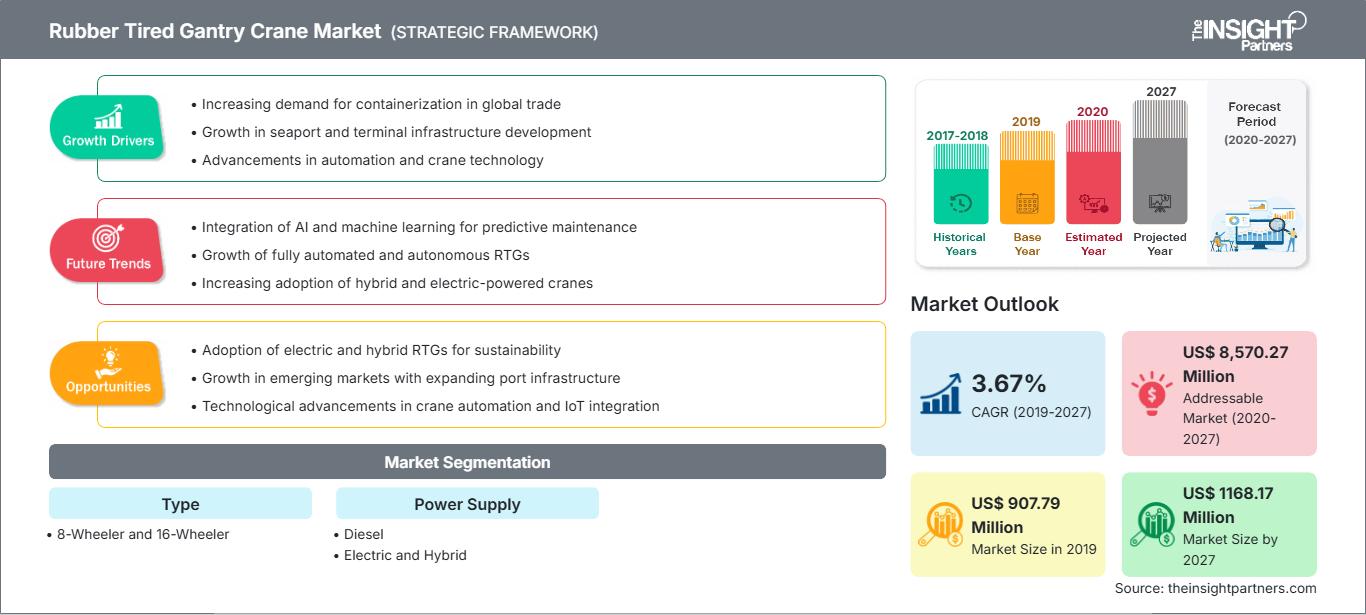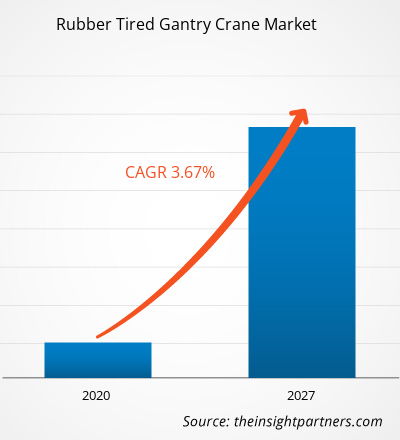2019年轮胎式龙门起重机市场价值为9.0779亿美元,预计到2027年将达到11.6817亿美元;预计2020年至2027年的复合年增长率为3.67%。
过去,发展中国家是原材料的供应国;然而,全球贸易格局赋予了发展中国家新的角色,因此,预计轮胎式龙门起重机市场在预测期内将出现显著增长。市场增长主要归因于海运贸易需求的增长,包括中国在内的发展中国家正在成为重要的海上货物进出口国,其中亚洲是最大的贸易区域。
此外,政府出台的港口发展优惠政策也推动了轮胎式龙门起重机市场的发展。港口如果运转良好,将成为经济的引擎。如今,港口的用途已不仅限于此,还扩展到物流平台。港口的生产力在国际贸易中至关重要,因为海港是一个国家对外贸易的神经。各国政府出台了多项政策,这些政策将在预测期内推动全球轮胎式龙门起重机市场的发展。
欧洲在2019年引领了轮胎式龙门起重机市场,预计在预测期内将继续保持主导地位。欧洲港口已采用电动轮胎式龙门吊(RTG)来减少污染和温室气体排放。该地区的政府法规允许采用电动集装箱装卸设备,例如在海上运输中进行碳排放核查。欧洲在产品和资产贸易中占有重要地位,例如机械、车辆、飞机、燃料、有色金属、纺织品、化学品、服装和原油。欧洲在贸易额方面位居第一,因此该地区在全球轮胎式龙门起重机市场中处于领先地位。
自定义此报告以满足您的要求
您将免费获得任何报告的定制,包括本报告的部分内容,或国家级分析、Excel 数据包,以及为初创企业和大学提供超值优惠和折扣
轮胎式龙门起重机市场: 战略洞察

-
获取本报告的主要市场趋势。这个免费样本将包括数据分析,从市场趋势到估计和预测。
COVID-19 疫情对轮胎式龙门起重机市场的影响
COVID-19 危机正在影响全球各行各业,预计全球经济将在 2020 年和 2021 年受到最严重的打击。疫情对消费电子、半导体、汽车和 IT 基础设施等主要行业造成了严重破坏。所有这些行业对于全球轮胎式龙门起重机市场的增长都至关重要,因为它们是轮胎式龙门起重机的主要需求产生行业。工厂停工、旅行禁令、贸易禁令和边境封锁影响了各种消费电子产品和零部件的生产和销售。由于供应链问题和制造业停工,全球电子和半导体行业是面临严重中断的主要行业之一。
市场洞察:绿色技术日益受到关注
由于政府对不同地区污染和排放限制的严格规定,市场参与者关注绿色技术。此外,可以优化配备电力驱动的 RTG 的使用,以降低功耗。起重机上使用电池混合动力技术将有助于大幅降低燃料消耗和有害化石燃料排放。港口货物装卸设备排放的柴油中约有 10% 是由 RTG 起重机排放的;使用更高效的 RTG 可直接减轻起重机运行对环境的影响。这项技术为全球繁忙的港口运营商提供了解决方案,他们需要提高效率,同时减少排放和运营对环境的影响,并带来降低运营成本、减少温室气体排放和降低码头噪音水平的额外好处。用于橡胶轮胎龙门起重机或 RTG 的飞轮储能技术,既可以改装到现有的 RTG 起重机上,也可以作为新建起重机的一部分。飞轮通过捕获集装箱下降时产生的制动能量来减少燃料消耗和排放。
基于类型的市场洞察
根据类型,全球轮胎式龙门起重机市场可分为两大类:8 轮和 16 轮。每种型号又有两种类型:8 轮为 8W 和 8WA,16 轮为 16W 和 16WA。两种型号的主要区别在于防摇系统的设计和龙门车轮的数量。16 轮 RTG 起重机需要更大的行驶区域。因此,它们不能在狭小的空间内使用。8 轮 RTG 起重机更适合较小的空间。
基于电源的市场洞察
根据电源,全球轮胎式龙门起重机市场可分为三类:柴油、电动和混合动力。为最大限度地减少全球排放而实施的严格排放标准、更高效电动汽车的开发以及燃油价格的上涨,都可能刺激全球对电动和混合动力轮胎式龙门起重机的需求。电动轮胎式龙门起重机性能更佳,可承载大量负载。因此,预计电动和混合动力轮胎式龙门起重机的市场需求将很快增长。
产品开发是企业扩展产品组合最常用的策略之一。Anupam Industries Limited、electromech Material Handling Systems (India) Pvt. ltd、科尼起重机、利勃海尔和卡尔玛等主要企业正在实施战略,以扩大客户群并在轮胎式龙门起重机市场中占据显著份额,从而在全球市场上保持其品牌声誉。
轮胎式龙门起重机市场
The Insight Partners 的分析师已详尽阐述了预测期内影响橡胶轮胎式龙门起重机市场的区域趋势和因素。本节还讨论了北美、欧洲、亚太地区、中东和非洲以及南美和中美洲的橡胶轮胎式龙门起重机市场细分和地域分布。
轮胎式龙门起重机市场报告范围
| 报告属性 | 细节 |
|---|---|
| 市场规模 2019 | US$ 907.79 Million |
| 市场规模 2027 | US$ 1168.17 Million |
| 全球复合年增长率 (2019 - 2027) | 3.67% |
| 历史数据 | 2017-2018 |
| 预测期 | 2020-2027 |
| 涵盖的领域 |
By 类型
|
| 覆盖地区和国家 |
北美
|
| 市场领导者和主要公司简介 |
|
轮胎式龙门起重机市场参与者密度:了解其对业务动态的影响
轮胎式龙门起重机市场正在快速增长,这得益于终端用户需求的不断增长,而这些需求的驱动因素包括消费者偏好的不断变化、技术进步以及对产品优势的认知度不断提高。随着需求的增长,企业正在扩展产品线,不断创新以满足消费者需求,并抓住新兴趋势,从而进一步推动市场增长。

- 获取 轮胎式龙门起重机市场 主要参与者概述
轮胎式龙门起重机市场细分:
按类型
- 8 轮车
- 16 轮车
按电源
- 柴油
- 电动
- 混合动力
公司简介
- Anupam Industries Limited
- ELECTROMECH MATERIAL HANDLING SYSTEMS (INDIA) PVT.有限公司
- 卡尔玛
- 科尼
- 利勃海尔
- Mi-Jack Products。
- REVA INDUSTRIES LTD
- 上海振华重工股份有限公司(ZPMC)
- TNT Crane & Ltd索具
- 三一集团
- 历史分析(2 年)、基准年、预测(7 年)及复合年增长率
- PEST和SWOT分析
- 市场规模、价值/数量 - 全球、区域、国家
- 行业和竞争格局
- Excel 数据集
近期报告
客户评价
购买理由
- 明智的决策
- 了解市场动态
- 竞争分析
- 客户洞察
- 市场预测
- 风险规避
- 战略规划
- 投资论证
- 识别新兴市场
- 优化营销策略
- 提升运营效率
- 顺应监管趋势






















 获取免费样品 - 轮胎式龙门起重机市场
获取免费样品 - 轮胎式龙门起重机市场